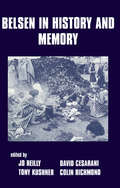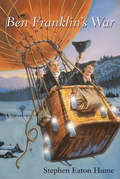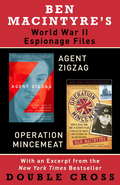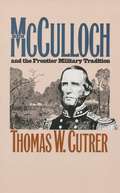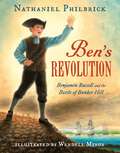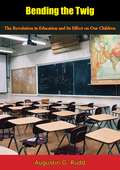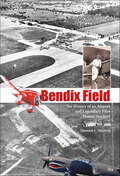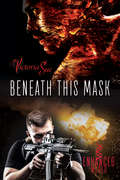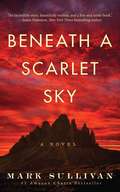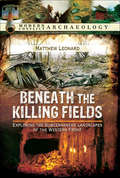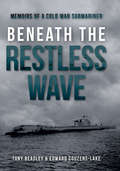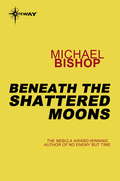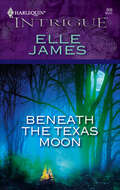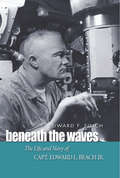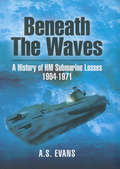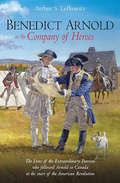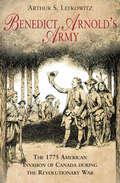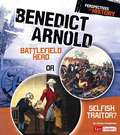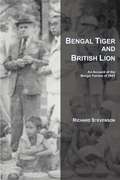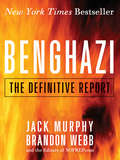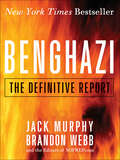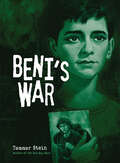- Table View
- List View
Belsen in History and Memory
by David Cesarani Tony Kushner Jo Reilly Colin RichmondDrawing on documentary and oral sources in Yiddish, Hebrew, German, Dutch and French, this book challenges many sterotypes about Belsen, and reinstates the groups hitherto marginalized or ignored in accounts of the camp and its liberation.
Ben Bennions DFC: Battle of Britain Fighter Ace
by Nick ThomasBen Bennion enlisted in the pre-war RAF, serving first as an 'erk' (ground crew) before being selected for pilot training. His first posting led to service in the Middle-East and Bennion's passport and other travel documents had to be rushed through. A clerical error led to his name being recorded as 'Bennions'.Ben served in 41 Squadron and following their overseas tour he returned to the UK and Catterick. Patrols and scrambles were common throughout the early months of the war, but it was in May 1940, that 41 Squadron first saw the enemy in any number, providing air cover for the retreating BEF. The Dunkirk operations saw Bennions record his first combat victory—he was to damage or destroy 20 plus enemy aircraft during the following months, earning the DFC and becoming one of the RAF's top scorers. The squadron alternated between Catterick and Hornchurch, and although Bennions was afforded some rest between operational periods, the front-line the sorties came thick and fast, particularly during the latter phases of the Battle of Britain when Bennions was flying several patrols and scramble every day. His tally grew steadily. His much deserved DFC was promulgated on 1 October 1940, the day he was due to begin a short period of leave. However he decided to have one last crack at the enemy and during this engagement, adding another Messerschmitt BF 109 to his total, he was hit and forced to bale out. Badly wounded in the head, Bennions lost an eye and became a member of Sir Archibald McIndoe's famous Guinea Pig Club.
Ben Franklin's War
by Stephen Eaton HumeAfter his "wonderful airship" crashes near St. Francis of Assisi’s Home for Foundlings in Quebec City, Ben Franklin is thrown slightly off course in his carefully laid plan to coax Canada into joining the Americans in their fight against England’s rule. A motley crew of orphans hides the famous inventor from the British Redcoats during the American War of Independence. One of these orphans, 16-year-old Michael Flynn, is deaf and was abandoned by his parents, who were convinced that his problem was caused by demons who "seized his tongue and prevented him from speaking." Michael leads his best friends, White Rat and Briony, through the dangerous spy portals of underground Montreal carrying secret messages to ensure Franklin eludes the gallows. When Michael’s sign language inspires the great scientist to create a top-secret spy code, Michael and his friends are flung headlong into an adventure they’ll never forget.
Ben Macintyre's World War II Espionage Files: Agent Zigzag, Operation Mincemeat
by Ben MacintyreAgent Zigzag and Operation Mincemeat, two thrilling accounts of World War II espionage, are available together as an ebook—with an excerpt from the New York Times bestseller Double Cross. &“Not since Ian Fleming and John le Carré has a spy writer so captivated readers.&”—The Hollywood ReporterAGENT ZIGZAG • &“Wildly improbably but entirely true . . . [a] compellingly cinematic spy thriller with verve.&”—Entertainment Weekly Eddie Chapman was a charming criminal, a con man, and a philanderer. He was also one of the most remarkable double agents Britain has ever produced. Inside the traitor was a man of loyalty; inside the villain was a hero. The problem for Chapman, his spymasters, and his lovers was to know where one persona ended and the other began. Based on recently declassified files, Agent Zigzag tells Chapman&’s full story for the first time. It&’s a gripping tale of loyalty, love, treachery, espionage, and the thin and shifting line between fidelity and betrayal. OPERATION MINCEMEANT • &“Brilliant and almost absurdly entertaining.&”—The New Yorker Near the end of World War II, two British naval officers came up with a brilliant and slightly mad scheme to mislead the Nazi armies about where the Allies would attack southern Europe. To carry out the plan, they would have to rely on the most unlikely of secret agents: a dead man. Ben Macintyre&’s dazzling, critically acclaimed bestseller chronicles the extraordinary story of what happened after British officials planted this dead body—outfitted in a British military uniform with a briefcase containing false intelligence documents—in Nazi territory, and how this secret mission fooled Hitler into changing military positioning, paving the way for the Allies to overtake the Nazis.
Ben Mcculloch and the Frontier Military Tradition
by Thomas W. Cutrer[A] well-written, comprehensively researched biography.--Publishers Weekly "Will both edify the scholar while captivating and entertaining the general reader. . . . Cutrer's research is impeccable, his prose vigorous, and his life of McCulloch likely to remain the standard for many years.--Civil War "A well-crafted work that makes an important contribution to understanding the frontier military tradition and the early stages of the Civil War in the West.--Civil War History "A penetrating study of a man who was one of the last citizen soldiers to wear a general's stars.--Blue and Gray "A brisk narrative filled with colorful quotations by and about the central figure. . . . Will become the standard biography of Ben McCulloch.--Journal of Southern History "A fast-paced, clearly written narrative that does full justice to its heroically oversized subject.--American Historical Review
Ben's Revolution: Benjamin Russell and the Battle of Bunker Hill
by Nathaniel PhilbrickHistory comes alive in this gripping account of a young boy caught up in the start of the Revolutionary War. Based on an episode in National Book Award–winning author Nathaniel Philbrick&’s New York Times bestseller Bunker Hill: A City, A Siege, A Revolution, this engrossing story allows readers to experience history from a child&’s perspective, and Wendell Minor&’s stunning paintings will transport readers back to the early days of the Revolutionary War. Benjamin Russell is in school on the morning of April 19th, 1775, when his teacher announces, &“The war&’s begun, and you may run!&” Ben knew this day was coming; after all, tensions had been mounting between the colonists and the British troops ever since the Boston Tea Party. And now they have finally reached the breaking point. Ben and his friends excitedly rush out of their classroom to bear witness, and follow the throngs of redcoats marching out of Boston toward Concord. Much to Ben&’s surprise, Boston is sealed off later that day—leaving the boys stuck outside the city, in the middle of a war, with no way to reach their families. But Ben isn&’t worried—he&’s eager to help the Patriots! He soon becomes a clerk to the jovial Israel Putnam, a general in the provincial army. For months he watches the militia grow into an organized army, and when the Battle of Bunker Hill erupts, Ben is awed by the bravery of the Patriots, although saddened by the toll war takes. He later goes on to become an apprentice at a Revolutionary newspaper, and it&’s a happy day when they get to report on the signing of the Declaration of Independence. Praise for Bunker Hill: A City, A Siege, A Revolution &“Philbrick guides us beautifully through Revolutionary Boston, with the Battle of Bunker Hill as his story&’s grand climax.&”—The New York Times Book Review &“Masterly narrative . . . Philbrick tells the complex story superbly . . . gripping book.&”—The Wall Street Journal &“A masterpiece of narrative and perspective. . . . This is not only . . . the greatest American story. It is also the American story.&”—The Boston Globe &“You will delight in the story and the multitude of details Philbrick offers up.&”—USA Today
Bending the Twig: The Revolution in Education and Its Effect on Our Children
by Augustin G. Rudd‘Tis education forms the common mindJust as the twig is bent the tree’s inclined—Alexander PopeAugustin G. Rudd in his book, Bending the Twig, clearly points out the implications of a program of liberal teacher training, and its effect on the public schools of the United States where the notions of Progressive or New Education have directly or indirectly influenced every level of our educational system.Part II of this book is especially valuable for its definition of the path the social educators are following. Augustin contrasts the concept of a free society based on the primacy of the individual with the concept of the statist order advocated by many of the New Educators who choose to use the schools as an instrument for social change rather than an agency for instruction in the skills, knowledges, and heritage necessary to maintain our culture.It is interesting to know that the Russians experimented with progressive education until its bad results became evident. Then, using their centralized power, they eliminated it. This return to the essentials of education may have aided Russia in making her recent technological advances.After reading this book, one comes away with the feeling that as generation after generation of students graduate from our schools conditioned to the tenets of socialism, we will eventually lose our republican form of government and individual liberty because our citizens will lack even the basic knowledge of our heritage.—FRANK B. KEITH, The Freeman, March 1958
Bendix Field: The History of an Airport and Legendary Pilot Homer Stockert
by Quentin L. HartwigExciting early history of Bendix Field, South Bend, Indiana
Beneath This Mask (Enhanced World Ser. #3)
by Victoria SueEnhanced World: Book ThreeGael Peterson has spent years hiding behind the enhanced abilities he wears like a mask, even though he is an important, confident member of the FBI’s exclusive H.E.R.O. team. The hurt and betrayal of his mom’s abandonment and his father’s fists are secrets buried deep beneath the ugly scars on his face, and he doesn’t trust Jake, his new regular human partner, with any of them. In a world where those with special abilities like Gael’s are regarded as freaks and monsters, it won’t be easy for him to rely on Jake to have his back, especially when the abilities of a vulnerable nonspeaking enhanced child make that child a murder suspect. Tempers rise and loyalties are challenged, and when the serial killer targeting the enhanced finally sets his sights on Gael, not only will Gael have to trust Jake with his secrets, he might have to trust him to save his life.
Beneath a Scarlet Sky by: A Novel
by Mark SullivanBased on the true story of a forgotten hero, Beneath a Scarlet Sky is the triumphant, epic tale of one young man’s incredible courage and resilience during one of history’s darkest hours. Pino Lella wants nothing to do with the war or the Nazis. He’s a normal Italian teenager—obsessed with music, food, and girls—but his days of innocence are numbered. When his family home in Milan is destroyed by Allied bombs, Pino joins an underground railroad helping Jews escape over the Alps, and falls for Anna, a beautiful widow six years his senior. In an attempt to protect him, Pino’s parents force him to enlist as a German soldier—a move they think will keep him out of combat. But after Pino is injured, he is recruited at the tender age of eighteen to become the personal driver for Adolf Hitler’s left hand in Italy, General Hans Leyers, one of the Third Reich’s most mysterious and powerful commanders. Now, with the opportunity to spy for the Allies inside the German High Command, Pino endures the horrors of the war and the Nazi occupation by fighting in secret, his courage bolstered by his love for Anna and for the life he dreams they will one day share.
Beneath a Scarlet Sky: A Novel
by Mark SullivanPino Lella wants nothing to do with the war or the Nazis. He's a normal Italian teenager--obsessed with music, food, and girls--but his days of innocence are numbered. When his family home in Milan is destroyed by Allied bombs, Pino joins an underground railroad helping Jews escape over the Alps, and falls for Anna, a beautiful widow six years his senior. <P><P>In an attempt to protect him, Pino's parents force him to enlist as a German soldier--a move they think will keep him out of combat. But after Pino is injured, he is recruited at the tender age of eighteen to become the personal driver for Adolf Hitler's left hand in Italy, General Hans Leyers, one of the Third Reich's most mysterious and powerful commanders. <P><P>Now, with the opportunity to spy for the Allies inside the German High Command, Pino endures the horrors of the war and the Nazi occupation by fighting in secret, his courage bolstered by his love for Anna and for the life he dreams they will one day share. <P><P>Fans of All the Light We Cannot See, The Nightingale, and Unbroken will enjoy this riveting saga of history, suspense, and love.
Beneath the Killing Fields: Exploring the Subterranean Landscapes of the Western Front (Modern Conflict Archaeology Ser.)
by Matthew LeonardBeneath the Killing Fields of the Western Front still lies a hidden landscape of industrialised conflict virtually untouched since 1918. This subterranean world is an ambiguous environment filled with material culture that that objectifies the scope and depth of human interaction with the diverse conflict landscapes of modern war. Covering the military reasoning for taking the war underground, as well as exploring the way that human beings interacted with these extraordinary alien environments, this book provides a more all-encompassing overview of the Western Front. The underground war was intrinsic to trench warfare and involved far more than simply trying to destroy the enemys trenches from below. It also served as a home to thousands of men, protecting them from the metallic landscapes of the surface. With the aid of cutting edge fieldwork conducted by the author in these subterranean locales, this book combines military history, archaeology and anthropology together with primary data and unique imagery of British, French, German and American underground defences in order to explore the realities of subterranean warfare on the Western Front, and the effects on the human body and mind that living and fighting underground inevitably entailed.
Beneath the Restless Wave: Memoirs of a Cold War Submariner
by Edward Couzens-Lake Tony Beasley<p>A Royal Navy submariner and hero of the Cold War reveals his incredible true story of covert ops against the Soviets in this military memoir.<p> <p>Tony Beasley was just a teenager when he joined the Royal Navy in 1946. Throughout his training and specialization as a telegraphist, he anticipated a life above the water, not beneath it. But with the Cold War brewing, new threats emerged, and Beasely was sent to work on submarines. In this candid memoir, he recounts his adventures patrolling the seas and spying on the Soviet Fleet.<p> <p>Tony took part in numerous missions, including covert operations in the Barents Sea. Before this mission, the crew of the submarine was advised that if anything went wrong it “never happened.” When things inevitably did go wrong, Tony emerged a hero. For many years afterward, he wasn't allowed to tell anyone where he had been or what he had done. Now in his eighties, Tony finally gets to tell his story.<p>
Beneath the Shattered Moons
by Michael BishopTwelve thousand years in the future, mankind has survived two enigmatic, civilisation-destroying setbacks. Now a third holocaust is anticipated by the people of the island refuge of Ongladred. They fear destruction from invading barbarians of the Angromain Archipelagoes, the reappearance of a semi-mythical sea creature and the devious intervention of the neo-human Parfects. The imminent disaster is very much the concern of Ingram Marley, a government spy sent to keep surveillance over Stonelore - a secluded haven and the centre of free thought on Ongladred - and Gabriel Elk, Stonelore's master and resident genius. While panic and fear rage outside, deep inside Stonelore the mysteries of life are pursued - reanimation of the dead, the invention of powerful laser weapons and the secrets of 'old earth' knowledge. Amidst harrowing dangers of sea battles and land invasions, beneath the shattered moons, Ingram Marley's world is about to change beyond his wildest imaginings.
Beneath the Texas Moon (Eclipse Ser. #17)
by Elle JamesA single mom and a rugged rancher team up when danger stalks their Texas town in this romantic suspense tale by a New York Times–bestselling author.Eve Baxter thought tiny Spirit Canyon, Texas, was the perfect place to escape her nightmares and be alone with her son—but the drought-ridden town had more than its share of secrets and skeletons. Eve’s isolated ranch quickly went from haven to hell, driving her into the strong arms of brooding rancher Mac McGuire.But even Mac was dangerous, as he represented everything Eve was running from. As the temperatures soared and tempers flared, Eve feared that not even her cowboy protector could save her from the fate Spirit Canyon had in store. . . .
Beneath the Waves
by Edward F. FinchOne of the U.S. Navy s best known submarine officers, Capt. Edward L. Beach, enjoyed fame both as a bestselling author and as a highly decorated naval officer. Not long after the success of his first novel Run Silent, Run Deep, which was later made into a major feature film, he commanded the first submarine to circumnavigate the globe submerged. During World War II, Beach earned ten decorations for gallantry, including the Navy Cross, while on twelve combat patrols in the Pacific. Following the war, he became the public face of the submarine community and served as an aide to the first chairman of the Joint Chiefs of Staff and to President Dwight D. Eisenhower. All the while, he continued to write books, a total of ten, including three novels, before his death in 2002.
Beneath the Waves: A History of HM Submarine Losses, 1904–1971
by A.S. EvansSince the beginning of the Royal Navy Submarine Service in 1901, 173 submarines have been lost and in many circumstances with their entire crew. War inevitably takes a heavy toll: in World War Two alone 341 officer and 2,801 ratings failed to return to harbour. The loss of personnel was roughly equivalent to the strength of the Submarine Arm at the outbreak of war.Between the first loss, A1 in 1904, and the last, Artemis in 1971, lie many stories in which cool nerve was very much in evidence and one can marvel at the escape of the only survivor of Perseus; and of the sinking of Olympus from which the few survivors had to swim seven miles before receiving help; and of Surgeon-Lieutenant Charles Rhodes who died that others may live. These and many other accounts of submarine escape are described within this history and whenever possible in the words of survivors or witnesses.
Benedict Arnold in the Company of Heroes: The Lives of the Extraordinary Patriots Who Followed Arnold to Canada at the Start of the American Revolution
by Arthur S. Lefkowitz"Hundreds of Men followed Colonel Benedict Arnold northward on his famous expedition to capture Quebec in late December 1775. They joined with General Richard Montgomery, but after Montgomery was killed by enemy fire, his men retreated. Arnolds troops, however, continued fighting after Arnold fell wounded and only surrendered when hopelessly outnumbered and trapped inside the city. Who were these men and what became of them? Arthur Lefkowitz answers these questions in his fresh and compelling Benedict Arnold in the Company of Heroes.An award-winning writer on the American Revolution, Lefkowitz spent years searching through archival materials to paint splendid and compelling portraits of Arnolds amazing cast of veterans whose fates offer a fascinating glimpse into the lives of early American patriots. His original monograph begins with an overview of the failed Canadian invasion before following these men into prison (where some devised intricate plots to break out and even seize weapons to capture the city). Despite their hardships, many returned to the rebel army to continue their fight for independence.Arnolds men, explained George Washington, were worthy of particular notice and they never disappointed him. Some of those portrayed in detail include Charles Porterfield (who led troops at Brandywine); Daniel Morgan (the hero of Cowpens); Henry Dearborn and Timothy Bigelow (who fought alongside their old commander at Saratoga); Christian Febiger and Return Jonathan Meigs (who were at the forefront of the attack on Stony Point); Simeon Thayer (who refused to surrender Fort Mifflin); and Colonel Aaron Burr (whose impressive wartime record was marred by his tumultuous political career). What accounts for the inspired leadership of so many veterans from Arnolds expedition? Lefkowitz presents a compelling argument that they learned by example from Benedict Arnold, himself a courageous and charismatic officer.Original, fast-paced, and deeply researched, Benedict Arnold in the Company of Heroes is essential reading for everyone interested in our endlessly fascinating American Revolution."
Benedict Arnold's Army: The 1775 American Invasion of Canada During the Revolutionary War
by Arthur S. LefkowitzA brilliant American combat officer and this countrys most famous traitor, Benedict Arnold is one of the most fascinating and complicated people to emerge from American history. His contemporaries called Arnold the American Hannibal after he successfully led more than 1,000 men through the savage Maine wilderness in 1775. The objective of Arnold and his heroic corps was the fortress city of Quebec, the capital of British-held Canada. The epic campaign is the subject of Benedict Arnolds Army, a fascinating campaign to bring Canada into the war as the 14th colony. The initiative for the assault came from George Washington who learned that a fast moving detachment could surprise Quebec by following a chain of rivers and lakes through the Maine wilderness. Washington picked Col. Benedict Arnold, an obscure and controversial Connecticut officer, to command the corps who signed up for the secret mission. Arnold believed that his expedition would reach Quebec City in twenty days. The route turned out to be 270 miles of treacherous rapids, raging waterfalls, and trackless forests that took months to traverse. At times Arnolds men were up to their waists in freezing water dragging and pushing their clumsy boats through surging rapids and hauling them up and over waterfalls. In one of the greatest exploits in American military history, Arnold led his famished corps through the early winter snow, up and over the Appalachian Mountains, and on to Quebec. Benedict Arnolds Army covers a largely unknown but important period of Arnolds life. Award-winning author Arthur Lefkowitz provides important insights into Arnolds character during the earliest phase of his military career, showing his aggressive nature, need for recognition, experience as a competitive businessman, and his obsession with honor that started him down the path to treason. Lefkowitz extensively researched Arnolds expedition and made numerous trips along the same route that Arnolds army took. Benedict Arnolds Army also contains a closing chapter with detailed information and maps for readers who wish to follow the expeditions route from the coast of Maine to Quebec City. There is a growing interest in the Founding Fathers and the Revolutionary War as a source of national pride and identity and the Arnold Expedition as told through Benedict Arnolds Army is one of the greatest adventure stories in American history. Arthur S. Lefkowitz lives in central New Jersey
Benedict Arnold: Battlefield Hero or Selfish Traitor?
by Jessica GundersonSoldier and commander. Traitor and turncoat. Benedict Arnold has been called many names throughout history. But who was the real Benedict Arnold? Explore Arnolds life as he fights his way through the American Revolution. Then decide for yourself whether he was a hero or a villain.
Benedict Hall (Benedict Hall Novel Ser. #1)
by Cate CampbellIn this richly layered debut novel, Cate Campbell introduces the wealthy Benedict family and takes us behind the grand doors of their mansion, Benedict Hall. There, family and servants alike must face the challenges wrought by World War I--and the dawn of a new age brimming with scandal, intrigue, and social change.Seattle in 1920 is a city in flux. Horse-drawn carriages share the cobblestone streets with newfangled motor cars. Modern girls bob their hair and show their ankles, cafés defy Prohibition by serving dainty teacups of whisky to returning vets--and the wartime boom is giving way to a depression. Even within the Benedicts' majestic Queen Anne home, life is changing--above and below stairs. Margot, the Benedicts' free-spirited daughter, struggles to succeed as a physician despite gender bias--and personal turmoil. The household staff, especially longtime butler Abraham Blake, have always tried to protect Margot from her brother Preston's cruel streak. Yet war has altered Preston too--not for the better. And when a chance encounter brings a fellow army officer into the Benedict fold, Preston's ruthlessness is triggered to new heights. An engineer at the fledgling Boeing company, Frank Parrish has been wounded body and soul, and in Margot, he senses a kindred spirit. But their burgeoning friendship and Preston's growing wickedness will have explosive repercussions for everyone at Benedict Hall--rich and poor, black and white--as Margot dares to follow her own path, no matter the consequences.
Bengal Tiger and British Lion: An Account of the Bengal Famine of 1943
by Richard StevensonThis history of the Bengal Famine of 1943 describes the interplay of politics, economics, sociology and military policy, which caused a famine due to a lack of cash, not a lack of food. The Famine, whose story is almost unknown due to wartime censorship by the British, occurred because of a hyperinflation in the price of rice caused by the provisioning for the major offensive against the Japanese on India's eastern borders. Relief efforts were halfhearted because much of the countryside was in a state of endemic revolt against the British. The logistical problems caused by massive gifts of food by the British and Indian troops to the starving people threatened to stall the forthcoming offensive. The cause of the Famine was the deadly alienation between the Bengalis and their British rulers.
Benghazi: The Definitive Report
by Jack Murphy Brandon WebbOn September 12th, 2012, Brandon Webb learned Glen Doherty, one of his closest friends and his former Navy SEAL teammate, was killed alongside Ambassador J. Christopher Stevens and two other Americans when the U. S. State Department and CIA headquarters in Benghazi, Libya, were sieged in a shocking terrorist attack. For the next four months, Webb and his team at SOFREP. com, the world's premier Special Ops website, embarked on a relentless investigation to understand exactly what happened to their countrymen, as well as the roles played by the Obama administration, State Department, and CIA. Drawing on unmatched sources, they spoke to individuals who would talk to no one else, including fellow Special Operations team members familiar with the African theatre, and well-placed contacts in the Washington intelligence community. This is their report--an unforgettably gripping minute-by-minute narrative of the events and their aftermath as they really unfolded on that terrible day in Libya.
Benghazi: The Definitive Report
by Jack Murphy Brandon WebbNEW YORK TIMES BESTSELLERWritten by the team of former Special Operations warriors who run SOFREP.com, here is the definitive account of what happened before, during, and after the deadly Benghazi attack that claimed the lives of four Americans.On September 12th, 2012, Brandon Webb learned Glen Doherty, one of his closest friends and his former Navy SEAL teammate, was killed alongside Ambassador J. Christopher Stevens and two other Americans when the U.S. State Department and CIA headquarters in Benghazi, Libya, were sieged in a shocking terrorist attack. For the next four months, Webb and his team at SOFREP.com, the world’s premier Special Ops website, embarked on a relentless investigation to understand exactly what happened to their countrymen, as well as the roles played by the Obama administration, State Department, and CIA. Drawing on unmatched sources, they spoke to individuals who would talk to no one else, including fellow Special Operations team members familiar with the African theatre, and to well-placed contacts in the Washington intelligence community. This is their report—an unforgettably gripping minute-by-minute narrative of the events and their aftermath as they really unfolded on that terrible day in Libya.
Beni's War
by Tammar SteinIt's Yom Kippur Eve in 1973, and twelve-year-old Beni thinks his biggest problem is settling in at his new school in the Golan, where his family moved at the end of the Six-Day War. But on Yom Kippur, shocking news comes over the radio: a stunning strike on Israel has begun, led by a coalition of Arab states. In the blink of an eye, Beni's older brother Motti is off to war, leaving Beni behind with his mother and father. As bombs drop around Beni and his family, they flee to safety, every day hoping for news of Motti and the developments of the war. Beni must find a way to aid the war effort in his own way, proving that he too can be a hero, even as he learns along the way that there is dignity in every person, including the people he considers the enemy.
